
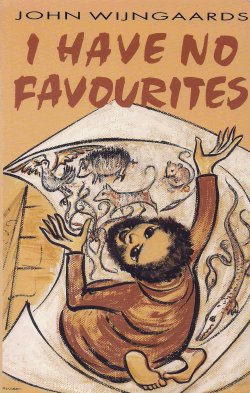 In presenting the inequalities of ancient Corinth we have
not yet paid attention to the situation of women. This is what we are going to
do now. Some women in upperclass families enjoyed new forms of freedom, as we
will discuss in chapter nine. But these were privileged. Most women still lived
under the heavy restrictions of traditional custom.
In presenting the inequalities of ancient Corinth we have
not yet paid attention to the situation of women. This is what we are going to
do now. Some women in upperclass families enjoyed new forms of freedom, as we
will discuss in chapter nine. But these were privileged. Most women still lived
under the heavy restrictions of traditional custom.
Corinth was officially a Roman colony, so we may well start with a look at Roman law. The husband was considered the head of the family. The wife, as well as the children and slaves, were firmly subjected to his power. (1) The wife was her husband's property. He held power of death and life in her regard. He could inflict any punishment on her which he deemed fit. Originally this included the right to sell her as a slave, or kill her if he found her to be unfaithful.
Strictly speaking, the wife could not possess anything as her own. Even the dowry she brought with her, or whatever she inherited from her own family, belonged to her husband. A woman could not be entrusted with any public office. She could not be a valid witness in court cases. If she needed to be involved in public business, she could only do so through an official person appointed to represent her. In other words: a woman's world was restricted to her home in which she was totally subject to her husband.
By the first century AD some relaxations had come into force which protected women from excessive violence by their husbands or from being robbed of their dowries. But men still had the final say in all family matters. They decided the fate of the children, what slaves to buy, where to live, what business the family would undertake. Adultery by a woman was a crime against her husband; adultery by a man only a transgression against another man's property, that is: the man's wife. (2)
The situation in the other cultures of the time was not much different. For the Greeks too, the woman belonged to the home. She was subject to her husband. Again, in spite of some exceptions (which we will discuss in chapter nine), women were dependent on men. And, as for the Romans, the reason was simply that women were considered inferior as human beings.
It is important for us to reflect on this for a moment. The reasons given in Roman law for restraining women's rights are variously described as 'the weakness of her sex' or 'the stupidity of her sex'. The context makes clear that the problem did not lie in women's physical weakness, but in what was perceived as her lack of sound judgement and her inability to think logically. Women were grouped with minors, slaves, convicted criminals and persons who were dumb and mute; that is, with people whose judgment could not be trusted. (3)
The thinking behind this was that the man rightly takes charge because he commands superior intelligence. This will also profit the woman who depends on him. The Greek philosopher Aristotle (384 - 322 BC) compares this to the relationship between human beings and tame animals.
'It is the best for all tame animals to be ruled by human beings. For this is how they are kept alive.
In the same way, the relationship between the male and the female is by nature such that the male is higher, the female lower, that the male rules and the female is ruled. (4)
What we should notice in Aristotle's text is the phrase: by nature.
Subordination is right because it corresponds to the way things have been made. Aristotle also reckons that slavery is natural because some people are by nature destined to be slaves.
'That person is by nature a slave who can belong to another person and who only takes part in thinking by recognising it, but not by possessing it. Other living beings (animals) cannot recognise thinking; they just obey feelings. However, there is little difference between using slaves and using tame animals: both provide bodily help to do necessary things.'
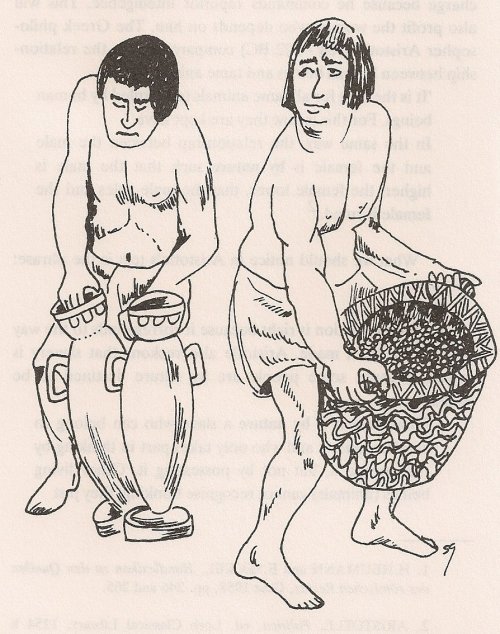 |
Aristotle then proceeds to describe a slave's position and it is truly terrifying. A slave is no more than 'a tool of his master'. Together with the wife and the ox, a male or female slave is a householder's indispensable beast of burden. He or she should be kept well — for simple economic reasons. But slaves have no right to leisure or free time. They own nothing and can take no decisions. They have no part in enjoyment and happiness, and are not members of the community.
For the same reason Aristotle also justifies wars to capture new slaves. For some people 'are by nature destined to be ruled, even though they resist it'; like wild animals that need to be tamed. He even says that all foreigners to some extent belong to this category.
'That is why the poets say: "It is correct that Greeks rule Barbarians"; for by nature what is barbarian and what is slave are the same. (6)
The prevailing tradition of Romans and Hellenists saw society, therefore, as layered in higher and lower forms of human being. Women were inferior to men by nature. Barbarians were inferior to Greeks by nature. Slaves were slaves because they were inferior by nature. This, we can be sure, is how most people thought in ancient Corinth.
The New Testament message contrasts sharply with this by its revolutionary new vision.
Their is neither Jew nor Greek, neither free nor
slave, neither male nor female.
For you are all one in Christ Jesus.
(Galatians 3,28.)
Unfortunately, this original vision of universal equality would soon be obscured by Christians themselves. It is a sad history which we must study, if we are to understand the ten- sions of our own time.
What happened, to make a long story short, is that Christians almost from the beginning lacked the spiritual enlightenment and will of character to break with the existing social systems. Instead of reaffirming people's new freedom in Christ, they gradually fell back into an acceptance of the previous, pagan world views.
As pagans before them had done, Christians too began to assert that God has created humankind in layers, with 'primitive races', slaves and women at the bottom.
Let us begin with slavery, because it is basic to the whole process of thought. We will have a quick look at these periods: the patristic times (3rd till 11th centuries), the Middle Ages (12th till 14th centuries), colonial expansion (15th till 19th centuries) and our own time.
During the patristic period the Church was ambivalent. In some cases the Church promoted the practice of emancipation of slaves by their masters. But, on account of the prevailing social climate and by a misreading of certain New Testament texts (see next chapter), this was not followed through. It was generally held that, though by nature all human beings are free, slavery had crept in as a consequence of original sin. Slavery could be imposed as a penalty on vicious or stupid people. This could work out to be beneficial to them. (7) In practice, most Christians did keep their slaves and local Church Councils imposed slavery as a punishment on certain transgressors.(8)
Were no prophetic voices raised in protest? Yes, they were. But they were not listened to. St.Gregory, Bishop of Nyssa, advocated the total abolition of slavery. 'To own people is to buy the image of God', he taught. He records that in his cathedral slaves were released from their bondage on the day of Easter 'according to the custom of the Church'. And he pleads for Christians to listen to their consciences.
'You condemn a person to slavery who by nature is free and independent, and so you make laws opposed to God and to his natural law. For you have subjected to the yoke of slavery a person who was made precisely to be lord of the earth and whom the Creator intended to be a ruler, thus resisting and rejecting his divine precept. Have you forgotten what limits were set to your authority? God limited your ownership only to brute animals ....(9)
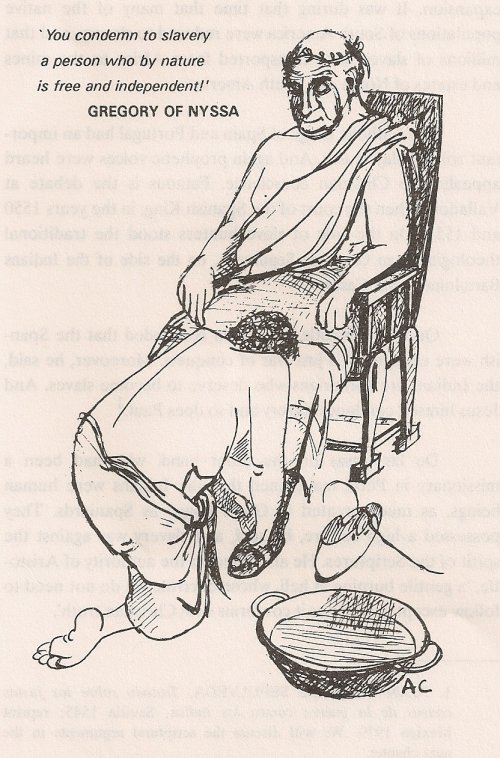 |
Alas! Such prophetic indictments were not heeded. On the contrary, in the Middle Ages the situation of slaves worsened because Christian theologians began to base their arguments more on philosophy and Roman law than on Scripture. Aristotle, especially, was very influential.
Thomas Aquinas, for instance, agreed to all the classical pagan views, with just a dash of holy water. Slavery, he said, is 'natural' in the sense that it is the consequence of sin, by 'the second intention of nature'. He justified slavery on these titles: penal enslavement; capture in conquest; people who sold themselves to pay off debts, or who were sold by a court for that reason; children born of a slave mother. (10)
This hardening of thought had not only serious consequences for the Middle Ages themselves when even Bishops and monasteries owned and exploited slaves. It prepared the ground for the great atrocities committed during colonial expansion. It was during that time that many of the native populations of South America were reduced to slavery, and that millions of slaves were transported from Africa to the mines and estates of North and South America.
The Catholic Kings of Spain and Portugal had an important role to play in this. And again prophetic voices were heard appealing to Christian conscience. Famous is the debate at Valladolid, then the court of the Spanish King, in the years 1550 and 1551. On the side of slave hunters stood the traditional theologian Juan Ginés de Sepúlveda, on the side of the Indians Bartolom6 de las Casas.
Quoting Aristotle, Sepúlveda contended that the Spanish were engaged in a just war of conquest. Moreover, he said, the Indians are barbarians who deserve to become slaves. And Jesus himself condones slavery and so does Paul. (11)
De las Casas on the other hand, who had been a missionary in Peru, maintained that the Indians were human beings, as much created in God's image as Spaniards. They possessed a high culture, he said, and slavery was against the spirit of the Scriptures. He also rejected the authority of Aristotle, 'a gentile burning in hell, whose doctrine we do not need to follow except in so far as it conforms with Christian truth'.
Here are some of De las Casas' pleadings:
'Our Christian religion is suitable for, and may be adapted to all the nations of the world, and all alike can receive it.
No single person may be deprived of his liberty; or enslaved on the excuse that he is a natural slave . . .
Are these Indians not people like us? Do they not have rational souls? Are we not obliged to love them as we love ourselves?’ (12)
Such protests were not welcome to slave traders and their colonial overlords. Small wonder that the slave traders won the day.
Saddest of all is the fact that the Roman Pontiffs, who should have been guardians of Christian truth, endorsed the theory and practice of slavery. In 1454 Pope Nicholas V sanctioned the practice of enslaving Muslims and other conquered nations. In 1493 Alexander VI authorised the King of Spain to enslave non-Christians of the Americas who were at war with Christianity. In 1548 Paul III restated the principle that citizens and members of the clergy could own slaves.
And even though in later centuries a succession of Popes were to denounce the slave trade of negroes from Africa, slavery as such was tolerated. (13) Many Protestant denominations were no better. In fact, slaves often fared better in colonies owned by Roman Catholic nations since religious leaders insisted on laws regulating their fair treatment.
One of the basic problems was the conviction, which had crept back into Christianity from paganism, that slavery was somehow tolerated by God. God, it was argued, had created some people inferior to others, thereby making them 'natural slaves'. For it was God who had created a hierarchy in things, with orders of submission. In the words of Sepúlveda, 'By natural law matter must obey the spirit, the body the soul, appetite reason, brute beasts human beings, the wife her husband, children a father, the imperfect (slaves) the perfect (their masters), the lower the higher, for the sake of the common good'.
Need we be surprised that in such a frame of thinking women too were denied their equal dignity as human beings?
In spite of the New Testament vision of equality, the inferiority of women to men was taken for granted during the first 1000 years of Christianity. Moreover, this lower status was seen confirmed in Scripture. Was it not through Eve that Adam had been seduced to sin? And, most decisive of all, was it not Adam who had been created first? Had Eve not been made from his rib, as his helper, as an 'afterthought'?
The relationship between men and women was laid down in the collection of Church laws assembled by Gratian of Bologna in 1140. (14) It became an authoritative source book for Canon Law in later centuries. Gratian draws many principles from classical Roman law, among them the rule that women are subject to men because of the weakness and stupidity of their sex. (15) 'A wife is in a condition of slavery by which she has to be subject to her husband in everything'.(16)
Gratian solemnly pronounces the thesis that a woman's subordination is a fact of nature, willed by God. He quotes from the Fathers of the Church to prove his point.
'It is the natural order of things among human beings that wives serve their husbands and children their parents. The justice of this lies in the fact that the lower should serve the higher.' (17) 'It is not without significance that woman was not created from the same earth from which Adam was moulded, but out of his rib. The man is therefore the head of the woman . . . It is contrary to the law and practice of nature that a woman who is a Christian and made subject by God's law, should wish to rule over a man. For even pagan women serve their husbands by the common law of nature.' (18)
Gratian even records the absolutely outrageous suggestion that women are not created in God's image. He cites St.Augustine and St.Ambrose as holding this view, but the texts he quotes are from a pseudo-Ambrose whom we now know as Ambrosiaster.
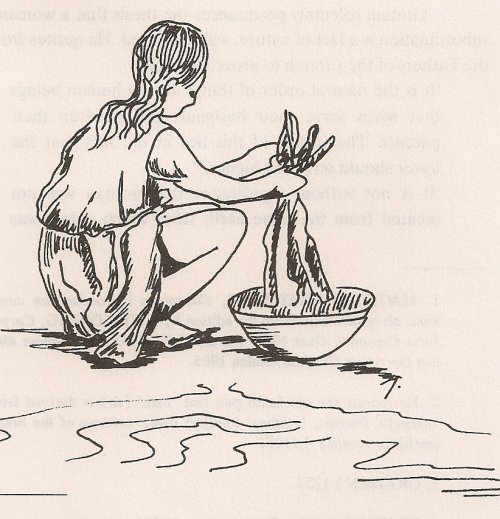 |
'The image of God resides in the man so that one person was made from whom the others originate, one who carries God's power, who is as it were his representative because he carries the image of the one God. Therefore woman is not made in God's image. For Scripture says: "God made man. In his image he made him".' (19)
Thomas Aquinas, the leading scholastic theologian, was led by similar arguments to defend a total submission of woman to man. For him, woman was 'an incomplete male'. (20) For this reason Christ could not have become incarnated as a woman. Women could not hold positions of authority in the Church or represent Christ in the ministry.
Again we notice that the socially dependent condition of women was blamed on God. It was God who as Creator had made women inferior by nature. (21)
The crucial religious question for Christians is: did God make some people inferior to others? Or is their subjection due to unjust domination by other human beings?
It is time for us to turn to Sacred Scripture and, first of all, to the most basic texts: the creation accounts. There are two of them, each impressive in its own right and each conveying vital supplementary teaching.
The first creation account, Genesis 1,1 - 2,4, narrates the origin of the universe as a building project by God, the Architect. (22) The world, as people knew it at the time, that is: the 4th century BC, was seen as a huge house. The floor was made up of the flat earth. The sky was its ceiling. The sun, moon and stars were lights for day and night. The fish in the sea, the plants and animals on the land and the birds in the air were seen as furniture put in by God, and as sources of food.
The climax of God's building work was the creation of human beings. They were special because the world was built to be their home. They were also special because, like God, they could think logically and act with responsibility. They carried God's own image.
God said: 'Let us make human beings in our own image,
in the likeness of ourselves,
and let them rule over the fish of the sea,
the birds of heaven, the cattle, all wild beasts
and the reptiles that crawl upon the earth'.
And God created the human in the image of himself.
In the image of God he created him.
Male and female he created them. (Genesis 1,27; literal translation of the Hebrew text.)
God then blessed human beings and gave them universal charge of the world. But God also expected them to remember that they were only creatures and that they should acknowledge the lordship of the Creator. That is why God built the world in six days and rested on the seventh to teach human beings that they should take time off for rest and worship on the Sabbath. (23)
From this account it is clear that all human beings are created in God's image. Both man and woman are mentioned explicitly in this context. As far as this text is concerned, all human beings are created with equal dignity, and with equal rights and duties. (24)
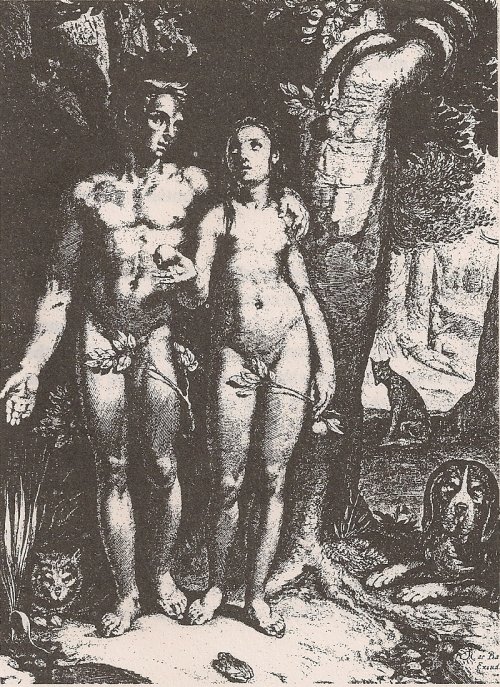 |
The second creation account teaches that God intended human beings to be happy, but that sin has brought unhap- piness and suffering (Genesis 2,5 - 3,24). Just like the first, this account may not be taken as a literal description as to how the world came about and how sin began. The story is a parable in which the details are images, not dogmatic facts.
In this account, our world is compared to a beautiful garden which God planted. God placed human beings in this garden to take care of it. But the human beings wanted to be more than just tenants; they wanted to be equal to God and have the garden for themselves. So God had to ban them from this paradise to a place full of suffering and hardship, where they had to fend for themselves. But one day God was to restore friendship with them. (25)
Within this context, let us read how the text deals with the creation of human beings.
Then Yahweh God moulded the earth-creature of soil from the earth and breathed into its nostrils the breath of life. So the earth creature became a living spirit. (Genesis 2,7.)
The author sees a close connection between the human being, adam, with 'earth' which is adamah in Hebrew. Human beings are a mixture of matter and spirit, of rootedness in the earth and an origin in God's creative breath. Since the earthy being had as yet no gender, in English it should be referred to as 'it'. We translate it as 'earth-creature'. (26)
Sensitivity to Hebrew is also essential in translating the next passages.
Yahweh God said, 'It is not good for the earth-creature to be alone. I will make it a companion like unto itself.'
So from the earth Yahweh God moulded all the animals and the birds of heaven. These he introduced to the earth-creature to see what it would call them; each one was to bear the name it gave them. The earth-creature gave names to all the cattle, the birds of heaven and the wild beasts. But not one of them was a companion like unto itself.
The 'companion like unto itself is not a 'helpmate', an assistant, a second-rate attendant. The Hebrew ezer denotes a real partner. (27)Scripture often calls God our ezer. The equality also follows from the inability of the animal world to produce such a partner.
So Yahweh God made the earth-creature fall into a deep sleep.
While it was sleeping, he took one 'side' from it and closed the gap with flesh.
Then Yahweh God built a 'wo-man' from the side he had taken from the earth-creature.
And he introduced her to the earth-creature.
The earth-creature exclaimed:
'This at last is bones from my bones and flesh from my flesh!
She will be called wo- man' because she was split off from a man.'
This is why a man leaves his father and mother and clings to his wo-man'.
And so they become (again) one body. (1. Genesis 2,18-24.)
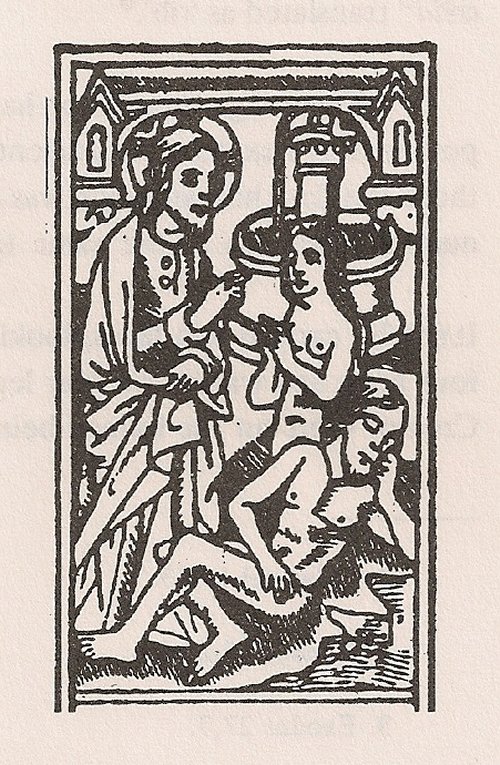 |
In this passage the author describes a marvellous transformation. God was often thought to act on human beings while they were in such a 'deep sleep'. (28) In this case God, as it were, split the earth creature into two equal parts. This interpretation of the text follows from the correct translation of tsêla°. This does not mean 'rib' but 'side'; such as the side of a mountain, (29) the side of the tabernacle, (30) the sides of the altar, (31) the side wings of the Temple gates (32) and even the 'wings' of the Temple building. (33) In fact, in no other verse of Scripture is the word tsêla° translated as 'rib'. (34)
The image the author has in mind becomes clear if we put his story next to other ancient creation stories. According to these the first human being was androgynous, that is: he/it was man and woman at the same time.
It/she/he carried two faces, looking in opposite directions, had four arms and walked on four legs. To make the two sexes, the Creator God cut the human being into two halves, giving each half one face, two arms and two legs. (35)
This may be the image which the scriptural author has in mind. God makes the earth-creature fall into a sleep of ecstasy. God then divides the creature into two equal halves: a man and a 'wo-man. (36) Rightly can the man exclaim that woman is bones from his bones and flesh from his flesh. For they are truly equal and need each other to become once more a complete body.
The second half of the story, which concerns the human slide into sin, does not overturn this image of equal dignity of man and woman. Both the man and the woman share in the rebellion against God. Both feel guilty and ashamed. On both hardship is inflicted as punishment. To be specific the text then mentions examples of typical human hardship: a man's toil to farm on hostile land, a woman's pain in childbirth and domination by the husband. (37) To the woman God says:
I will multiply your pains in childbirth.
You shall give birth to your children in pain.
You will long for your husband, but he will lord it over you.' (Genesis 3,16 .)
This is not to be understood as a license to husbands to keep their wives in submission. It is a statement of fact. It notes the consequences of sin. In a perfect world men would not need to struggle to grow crops amidst drought, disease and locusts. In the same perfect world women would not have pain in childbirth or face bullying by their husbands. Moreover, the text promises a return to better things when the offspring of the woman was to win the victory over evil. (38)
The second creation account, therefore, confirms what we have seen in the first. Human beings are created in God's image; they are God's own breath caught in matter. Men and women are equal partners, entrusted with the task of looking after this world. If inequalities have crept into human society, these are not according to God's design but are the consequences of human sin.
Put yourself back into Corinth, two thousand years ago. Deep and fundamental divisions split society. Greeks and Romans were convinced that some people were made to be free, others made to be slaves. Women were by nature inferior to men in general, and made to serve their husbands. Even the Jews agreed to these divisions, believing they were willed by God. They even added their own: the distinction between the chosen children of Abraham and the Gentiles.
These age-old prejudices with their roots deeply embedded in social structures and contemporary culture could not be eradicated at once. But a man like Paul clearly saw that Christ had established a totally new reality in which such distinc- tions were no longer valid. In Christ people are 're-created'.
This is what Paul wrote:
You have put off your old nature with its practices.
You have put on a new nature
which is being renewed in knowledge in the image of its Creator.
In that image there is no room for distinctions
between Greek and Jew, circumcised and uncircumcised,
between barbarian and Scythian, slave and free.
But Christ is all, Christ is in all. (Colossians 3:9-11.)
Neither circumcision matters, nor uncircumcision,
but whether you are a new creature ....
For all of you who have been baptised in Christ, have put on Christ.
There is neither Jew nor Greek,
neither free nor slave, neither male nor female.
For you are all one in Christ Jesus. (Galatians 6,15; 3,27-28.)
It is Christ who has restored the original purpose of creation.
1. What have these two curious facts in common?
*In 1772 Granville Sharpe succeeded in having the slave James Somerset legally set free. However, the court required a scientific opinion to establish that a black man is a human being.
*In 1872 Theodor Bischoff in Munich published his scientific opinion that women are incapable of university education. He based this conclusion on the shape and volume of a woman's skull.
2. In 1830 a Flemish Bishop preached in these words:
'Divine Providence has preordained that some of us be poor and some of us rich. This is one of the most evident proofs of God's goodness and wisdom. Indeed, the inequality is the most solid bond that ties classes together.To a certain extent it may seem that God abandons those who are crushed under the burden of misery. However, from a wider perspec- tive, he uses this poverty to give the rich a chance to be charitable'. S.H.SCHOLL, 150 JaarKAJ, Brussels 1963, p. 120.
What do you make of that? Give your reasons.
1. The man is described as the pater familias ('father of the family'). His power is patria potestas.
2. L.WENGER, Institutes of the Roman Law of Civil Procedure, Littleton 1940; F.SCHULZ, Classical Roman Law, London 1951; M.KASER, Roman Private Law, Oxford 1965.
3. H.HEUMANN and E.SECKEL, Handlexikon zu den Quellen des romischen Rechts, Graz 1958, pp. 246 and 265.
4. ARISTOTLE, Politica, ed. Loeb Classical Library, 1254 b 10-14.
5. All these are ARISTOTLE's literal words in his treatise Politika, vol. 1; see A.TH. VAN LEEUWEN, The Nacht van het Kapitaal, Nijmegen 1984, pp. 182 - 205.
6. ARISTOTLE, Physica, vol. 1; Loeb Classical Library, 1252 b 8.
7. AUGUSTINE held this view (354-430 AD); The City of God, 19, 15; Questions concerning the Heptateuch, 1, 153. It was a view repeated again and again through the centuries.
8. The Fourth Council of Toledo (633 AD), the Ninth Council of Toledo (655 AD), the Council of Pavia (1012 AD), the Synod of Melfi (1089 AD).
9. GREGORY OF NYSSA, Ecclesiastes, Hom.4; MIGNE, Greek Fathers, Vol.44, 549-550. Gregory adduces many other arguments: how slaves can be seen to be equal to their masters as human beings; what price could ever buy human freedom; etc.
10. THOMAS AQUINAS, In II Sententiarum d.44, q.l, a.3; In III Sententiarum d.36, q.l, a. 1 and a. 1, ad 2; Summa Theologica I- II, q.94, a.5, ad 3; II-II, q.57, a.3, ad 2. Children of a slave mother are rightly slaves even though they have not committed personal sin! Summa Theologica III, Suppl. q.52, a.4.
11. JUAN GINES DE SEPULVEDA, Tratado sobre las justas causas de la guerra contra los indios, Sevilla 1545; reprint Mexico 1979. We will discuss the scriptural arguments in the next chapter.
12. BARTOLOMÉ DE LAS CASAS, Unas Avisos y Reglas, etc.; El Indio Esclavo; Disputa o controversia con Ginés de Sepúlveda; all three books at Sevilla in 1552; reprinted at Madrid in 1958.
13. Slavery existed in the Papal States until the end of the 18th century. Slaves were kept in some ecclesiastical institutions as late as 1864. Extensive background material is provided by J.F.MAXWELL, 'The Development of Catholic Doctrine concerning Slavery', World Justice 11 (1969-70) pp. 147-192; 291- 324; Slavery and the Catholic Church, Chichester 1975.
14. MAGISTER GRATIANUS, Concordia discordantium canonum: all quotes here from the edition by A.FRIEDBERG, Corpus Juris Canonici, Graz 1955; see also J.F.SCHULTE, Summa über das Decretum Gratiani, Aalen 1965.
15. He repeats the old Latin pun that 'man' (vir) is derived from 'strength' (virtus), 'woman' ( mulier) from 'softness of the brain' (mollities mentis) ; I 1145.
16. GRATIAN I 1254.
17. GRATIAN, quoting St.Augustine; I 1254.
18. GRATIAN, quoting St.Jerome; I 1255-1256.
19. GRATIAN I 1254.
20. Literally he says: 'a failed male'. Relying on Aristotle (About the Generation of Animals, 11,3) Thomas' contemporaries thought that the female somehow resulted from a defect in propagation. Moreover, since they were ignorant of the role the female ovum plays in conception, they ascribed all generative power to the male seed; THOMAS AQUINAS, Summa Theologica I q.92 a.2; q.99, a.2 ad 1.
21. In the same way God was said to have made some people rich, others poor; J.B.Bossuet, Politique tirée des propres paroles de l’Écriture Sainte, Paris 1672.
22. Please, read the account in a good translation.
23. There is absolutely no contradiction between this account and evolution. Genesis does not teach how the world was created; only the fact that it was created by God and given to human beings as their home. The ‘seven days’ are no more than a literary device.
24. This teaching was lost in later Judaism. Male Jews would thank God three times a day for not having created them a pagan, a slave or a woman. 'Blessed are you, Lord our God, King of the universe, for not having made me a gentile, . . . for not having made me a slave, ... for not having made me a woman.' This prayer of the 18 Blessings is still recited by orthodox Jews today; Siddur Tehillat Hashem, New York 1982, p.8.
25. The author (Judah, 9th century BC?) uses popular images of the time such as Eden, the tree of life, the snake as evil personified, nakedness as a symbol of childlike innocence, and so on.
26. In Hebrew, 'he' and 'it' are the same word; see F.FERDER and J.HEAGLE, Partnership, Notre Dame 1989, pp. 31-46.
27. Hosea 13,9; Psalm 33,20; 70,6; 115,9; 146,5; Exodus 18,4.
28. God concluded a covenant with Abram while he was in a deep sleep (Genesis 15,12-21). He made people see visions and dreams in such a state (Job 4,13; 33,15; Daniel 8,18; 10,9).
| 29. 2 Samuel 16,13. | 30. Exodus 26,20-35. | 31. Exodus 27,7. | 32. 1 Kings 6,34. | 33. Ezekiel 41,5-26. |
34. For a discussion of these issues, read: L.ARNALDICH, 'La Creacion de Eva', Sacra Pagina 1 (1959) pp. 346-357; J.J.O'ROURKE, 'Early and Modern Theologians and Eve's Formation from Adam', Sciences Ecclésiastiques 13 (1961) pp. 427-435; J.DE FRAINE, Genesis, Roermond 1963, pp. 50-51; Ph.TRIBLE, 'Eve and Adam: Genesis 2-3', in Womanspirit Rising, New York 1979, pp. 74-83.
35. A full record can be found with PLATO (428-348 BC) in his Symposion ch. 14-16. The story was also known to the Jews and often linked to the Genesis story by Rabbis; see R.GRAVES and R.PATAI, Hebrew Myths. The Book of Genesis, London 1965, pp. 65-69.
36. In Hebrew the words are related: man is ish; woman ishshah.
| 37. Genesis 3,1-19. | 38. Genesis 3,15. |